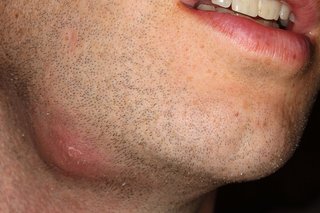An abscess is a painful collection of pus, usually caused by a bacterial infection. Abscesses can develop anywhere in the body.
This guide is about 2 types of abscess:
- skin abscesses - these develop under the skin
- internal abscesses - these develop inside the body, in an organ or in the spaces between organs
Symptoms of an abscess
A skin abscess often appears as a swollen, pus-filled lump under the surface of the skin. You may also have other symptoms of an infection, such as a high temperature and chills.

It's more difficult to identify an abscess inside the body, but signs include:
- pain in the affected area
- a high temperature
- generally feeling unwell
Read more about the symptoms of an abscess
When to see your GP
Talk to your GP if you think you have an abscess. They can examine a skin abscess or refer you to a hospital if they think you might have an internal abscess.
There are several tests available to help diagnose an abscess. The type of test depends on where the abscess is on your body.
Read about diagnosing an abscess
Causes of abscesses
Most abscesses are caused by a bacterial infection.
Your immune system fights the bacteria with white blood cells.
When this happens, some nearby tissue dies, creating a hole that fills with pus to form an abscess. The pus contains a mixture of dead tissue, white blood cells and bacteria.
Internal abscesses often develop as a complication of an existing condition. For example, an infection somewhere else in your body.
Read about the causes of an abscess
Treating an abscess
A small skin abscess may drain naturally. It may also shrink, dry up and disappear without any treatment.
You may need to treat a larger abscess with antibiotics, or the pus may need to be drained. This is done by inserting a needle through the skin or by making a small incision in the skin over the abscess.
Read more about treating an abscess
Preventing a skin abscess
Most skin abscesses are caused by bacteria getting into:
- a minor wound
- the root of a hair
- a blocked oil or sweat gland
Make sure your skin is clean, healthy and free of bacteria. This can help reduce the risk of developing a skin abscess.
Wait until the abscess is fully treated and healed before using any communal equipment. For example, gym equipment, saunas or swimming pools.
You can also reduce the risk of bacteria spreading by:
- washing your hands regularly
- encouraging people in your family to wash their hands regularly
- using separate towels and not sharing baths
Do not squeeze the pus out of the abscess. This can easily spread the bacteria to other areas of your skin. If you use tissues to wipe away any pus, throw them in the bin straight away to avoid germs spreading. Wash your hands after.
Take care when shaving your face, legs, underarm areas or bikini area to avoid nicking your skin, do not:
- share razors
- share toothbrushes
- use unclean razors
- use blunt razors
You can also reduce your risk by:
- maintaining a healthy, balanced diet
- losing weight if you're overweight or obese
- stopping smoking
It's difficult to prevent internal abscesses, as they're often complications of other conditions.
Other types of abscess
There are many other types of abscess, including:
- an anorectal abscess - a build-up of pus inside the bottom (rectum and anus)
- a Bartholin's cyst - a build-up of pus inside one of the Bartholin's glands. These are on each side of the opening of the vagina
- a brain abscess - a rare but potentially life-threatening build-up of pus inside the skull
- a dental abscess - a build-up of pus under a tooth or in the supporting gum and bone
- a quinsy (peritonsillar abscess) - a build-up of pus between one of the tonsils and the wall of the throat
- a pilonidal abscess - a build-up of pus in the skin of the cleft of the buttocks (where the buttocks separate)
- a spinal cord abscess - a build-up of pus around the spinal cord
Content supplied by the NHS and adapted for Ireland by the HSE
